Project grant
Development and validation of mechanisms-based in vitro transformation assays for carcinogen screening

At a glance
Completed
Award date
January 2009 - March 2012
Grant amount
£299,046
Principal investigator
Professor Robert Newbold
Institute
Brunel University
R
- Replacement
Read the abstract
View the grant profile on GtR
